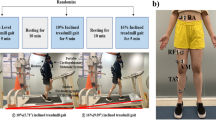Abstract
This study determined mechanical power during movements specific to maximal walking and running using a non-motorized treadmill in 38 elderly [69.4 (5.0) years] and 50 young [24.3 (3.4) years] men. The mean mechanical power over a period of time covering six steps, during which the belt velocity peaked and then kept almost plateau, was determined as a performance score in each of maximal walking (WP) and running (RP). In terms of the value relative to body mass, the relative difference between the two age groups was greater for RP (61.7%) than for WP (21.4%) or isometric knee extension (34.1%) and flexion torque (43.8%). In the two groups, WP was significantly (P<0.05) correlated to knee extension (r=0.582 for the elderly and r=0.392 for the young) and flexion torque (r=0.524 for the elderly and r=0.574 for the young). Similarly, RP was also significantly (P<0.05) correlated to knee extension (r=0.627 for the elderly and r=0.478 for the young) and flexion torque (r=0.500 for the elderly and r=0.281 for the young). In these relationships, the WP adjusted statistically by thigh muscle torque was similar in the two age groups. However, the corresponding value for RP was significantly higher in the young than in the elderly. The findings here indicate that: (1) the difference between the young and elderly men in mechanical power is greater during maximal running than maximal walking, and (2) although the thigh muscle torque contributes to the power production during the two maximal exercise modes in the two age groups, the RP is greater in the young than in the elderly regardless of the difference in the thigh muscle torque.




Similar content being viewed by others
References
Bassey EJ, Fiatarone MA, O’Neill EF, Kelly M, Evans WJ, Lipsitz LA (1992) Leg extensor power and functional performance in very old men and women. Clin Sci 82:321–327
Bonnefoy M, Kostka T, Arsac LM, Berthouze SE, Lacour J-R (1998) Peak anaerobic power in elderly men. Eur J Appl Physiol 77:182–188
Bosco C, Komi PV (1980) Influence of aging on the mechanical behavior of leg extensor muscles. Eur J Appl Physiol 45:20–219
Brooks S, Burrin J, Cheetham ME, Hall GM, Yeo T, Williams C (1988) The responses of the catecholamines and β-endorphin to brief maximal exercise in man. Eur J Appl Physiol 57:230–234
Chamari K, Ahmaidi S, Fabre C, Massé-Biron J, Préfaut C (1995) Anaerobic and aerobic peak power output and the force-celocity relationship in endurance-trained athletes: effects of aging. Eur J Appl Physiol 71:230–234
Cheetham ME, Boobis LH, Brooks S, Williams C (1986) Human muscle metabolism during sprint running. J Appl Physiol 61:54–60
De Vito G, Bernardi M, Forte R, Pulejo C, Macaluso A, Figura F (1998) Determinants of maximal instantaneous muscle power in women aged 50–75 years. Eur J Appl Physiol 78:59–64
Falk B, Weingstein Y, Dotan R, Abramson DA, Mann-Segal D, Hoffman JR (1996) A treadmill test of sprint running. Scand J Med Sci Sports 6:259–264
Fiatarone MA, Marks EC, Ryan ND, Meredith CN, Lipsitz LA, Evans WJ (1990) High-intensity strtength training in nonagenarians. JAMA 263:3029–3034
Funato K, Yanagiya T, Fukunaga T (2001) Ergometry for estimation of mechanical power output in sprint running in human using a newly developed self-driven treadmill. Eur J Appl Physiol 84:169–173
Gaitanos GC, Nevill ME, Brooks S, Williams C (1991) Repeated bouts of sprint running after induced alkalosis. J Sports Sci 9:355–370
Greenhaff PL, Nevill ME, Soderlund K, Bodin K, Boobis LH, Williams C, Hultman E (1994) The metabolic responses of human type I and IImuscle fibres during maximal treadmill sprinting. J Physiol (Lond) 478:149–155
Izquierdo M, Aguado X, Gonzalez R, Lópes JL, Hãkkinen K (1999) Maximal and explosive force production capacity and balance performance in men of different ages. Eur J Appl Physiol 79:260–267
Judge JO, Underwood M, Gennosa T (1993) Exercise to improve gait velocity in older persons. Arch Phys Med Rehabil 74:400–406
Kwon IS, Oldaker S, Schrager M, Talbot LA, Fozard JL, Metter EJ (2001) Relationship between muscle strength and the time taken to complete a standardized walk-turn-walk test. J Gerontol A Biol Sci Med Sci 56:B398–B404
Margaria R, Aghemo P, Rovelli E (1966) Measurement of muscular power (anaerobic) in man. J Appl Physiol 21:1661–1669
Metter EJ, Conwit R, Tobin J, Fozard JL (1997) Age-associated loss of power and strength in the upper extremities in women and men. J Gerontol A Biol Sci Med Sci 52:B267–B276
Ploutz-Snyder LL, Manini T, Ploutz-Snyder RJ, Wolf DA (2002) Functionally relevant thresholds of quadriceps femoris strength. J Gerontol A Biol Sci Med Sci 57:B144–B152
Rantanen T, Avela J (1997) Leg extension power and walking speed in very old living independently. J Gerontol A Biol Sci Med Sci 52:M225–M231
Rantanen T, Guralnik JM, Izmirlian G, Williiamson JD, Simonsick EM, Ferrucci L, Fried LP (1998) Association of muscle strength with maximum walking speed in disabled older women. Am J Phys Med Rehabil 77:299–305
Schlicht J, Camaione DN, Owen SV (2001) Effect of intense strength training on standing balance, walking speed, and sit-to-stand performance in older adults. J Gerontol A Biol Sci Med Sci 56:M281–M286
Sipilä S, Multanen J, Kallinen M, Era P, Suominen H (1996) Effects of strength and endurance training on isometric muscle strength and walking speed in elderly women. Acta Physiol Scand 156:457–464
Skelton DA, Greig CA, Davies JM, Young A (1994) Strength, power and related functional ability of healthy people aged 65–89 years. Age Ageing 23:371–377
Young A, Skelton DA (1994) Applied physiology of strength and power in old age. Int J Sports Med 15:149–151
Acknowledgements
This study was partly supported by financial aid from the Ministry of Education, Culture, Sports, Sciences and Technology (no. 12480007) and the Basic Research for Life and Society, STA.
Author information
Authors and Affiliations
Corresponding author
Rights and permissions
About this article
Cite this article
Yanagiya, T., Kanehisa, H., Tachi, M. et al. Mechanical power during maximal treadmill walking and running in young and elderly men. Eur J Appl Physiol 92, 33–38 (2004). https://doi.org/10.1007/s00421-004-1049-x
Accepted:
Published:
Issue Date:
DOI: https://doi.org/10.1007/s00421-004-1049-x




